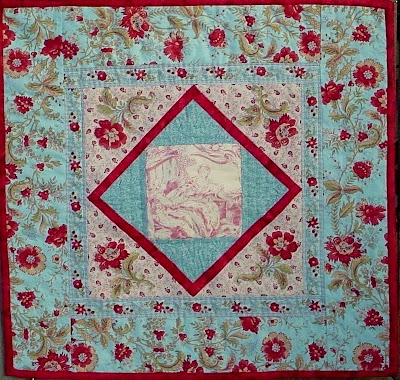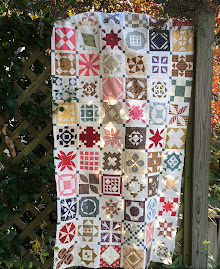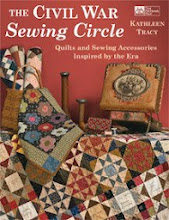Monday, March 15, 2010
Quilter's survey--oops!
Sorry about that if the most recent post did not make sense--I hit publish way too soon by mistake last night and you all got to read my unfinished blog post! Caught it this morning. If I have time today I might actually finish it . . .
Wednesday, March 10, 2010
Mrs. March
Mrs. March? Like the mother, Marmee, in Little Women? No, not exactly . . .
But, changing the subject--Here's a question for you. What's the best batting to use for little quilts? This is a question I get asked at almost EVERY single workshop or lecture I give. What kind of batting do I use to make my quilts look so soft and have that antique look, like they've been played with often? There are so many battings to choose from it gets downright confusing. Thick or thin, cotton or polyester? Silk or bamboo? Batting comes in a variety of thicknesses (thickness = loft). For my small quilts, I prefer a flat look, the kind you see in antique quilts. They've been washed and worn so much it almost looks as if they contain no batting at all.
So I like to use a thin cotton batting (low-loft) and think it's particularly great for small quilts because of the way the quilts drape (or hang). Thin batting is also very light and easy to hand quilt. I hate it when I choose a batting for my small quilt and it turns out puffy--some of my early quilts were like that because I was inexperienced at the batting thing. I didn't know that's how a quilt turned out if you used polyester batting. So I tried a lot of different cotton battings instead, and found that some were so thick that I couldn't get a needle through when I tried to hand quilt my quilts. And the quilt didn't drape well when I placed it on a doll bed, just stuck straight out. After a little bit of trial and error, I eventually found a batting I liked--Fairfield's 100% natural, all cotton batting. PERFECT for my doll quilts! I use it all the time and tell others about it when they ask what I use.
But, changing the subject--Here's a question for you. What's the best batting to use for little quilts? This is a question I get asked at almost EVERY single workshop or lecture I give. What kind of batting do I use to make my quilts look so soft and have that antique look, like they've been played with often? There are so many battings to choose from it gets downright confusing. Thick or thin, cotton or polyester? Silk or bamboo? Batting comes in a variety of thicknesses (thickness = loft). For my small quilts, I prefer a flat look, the kind you see in antique quilts. They've been washed and worn so much it almost looks as if they contain no batting at all.
So I like to use a thin cotton batting (low-loft) and think it's particularly great for small quilts because of the way the quilts drape (or hang). Thin batting is also very light and easy to hand quilt. I hate it when I choose a batting for my small quilt and it turns out puffy--some of my early quilts were like that because I was inexperienced at the batting thing. I didn't know that's how a quilt turned out if you used polyester batting. So I tried a lot of different cotton battings instead, and found that some were so thick that I couldn't get a needle through when I tried to hand quilt my quilts. And the quilt didn't drape well when I placed it on a doll bed, just stuck straight out. After a little bit of trial and error, I eventually found a batting I liked--Fairfield's 100% natural, all cotton batting. PERFECT for my doll quilts! I use it all the time and tell others about it when they ask what I use.
Bonus: If you go to the Fairfield website home page (below), you'll notice that yours truly is the Fairfield Designer of the Month for MARCH! (Mrs. March, you could say, get it?) All this month, because I love their batting and want everyone to know about it, there will be a free pattern on their website for a doll quilt I made for them, using their batting of course. You can see it there all month, to download and print out.
Here's the link to the free doll quilt pattern on their website.
So, sorry to disappoint--No, I will not be playing Marmee (Mrs. March) in a new Broadway version of Little Women or anything like that.
Although I have loved the book since childhood (and own a very old copy a friend gave to me years and years ago), have seen both movies many times, plus the live musical, and once dragged my husband and kids to visit Louisa May Alcott's house in Concord, MA when we vacationed out east, that's about as far as it goes.
Although, now that I think about it, I have to say that maybe there ARE some similarities between me and the author or her characters.
I must thank About.com for the following info on Louisa and her book to help me realize the similarities:
"In Little Women, Marmee offers moral guidance and unconditional love to her girls: Meg, Jo, Beth, and Amy."
(Me: I have one girl and one girl dog--my girls--I give moral guidance and uncondtional love to them on a daily basis. I give guidance to one of them to make sure she doesn't pee in the house. But I still give her unconditional love if she does. And paper towels to the other one to clean up the mess.)
"Louisa May Alcott drew from her own childhood experiences to dramatize the joys and sorrows of the March family."
(Me: I draw from my childhood experiences and my children's experiences ALL THE TIME in making my quilts and writing my books, remember?)
(Me: I draw from my childhood experiences and my children's experiences ALL THE TIME in making my quilts and writing my books, remember?)
"In the novel, the sisters come of age, with the Civil War in the background."
(Me: I have 4 sisters who are aging and I like reading about the Civil War and collecting Civil War reproduction fabrics. Just kidding, if any of them are reading this . . . )
"Louisa May Alcott was friends with Ralph Waldo Emerson and took walks with Thoreau."
(Me: I was an English major and I love Emerson and Thoreau too! Quote them often. Visited Walden Pond twice! Even bought a t-shirt that says: "Member of the Thoreau Sauntering Society." Sadly, the t-shirt no longer fits, probably because I sauntered a little too much for my own good when I should have been jogging . . . . )
"Marmee is always there for the girls--to oversee their antics, allay their fears, and heal their troubled hearts."
(Me: I work at home so I am ALWAYS there, ALWAYS watching over my kids' antics and ALWAYS asking about their troubled hearts, so much that they wish I'd just give it a rest sometimes. And throw the camera away while I'm at it . . . )
"Louisa May Alcott's own mother, Abigail May (Abba) Alcott, was the basis for Marmee in her novel, Little Women. Alcott once wrote of her mother: 'A great heart that was home for all.' Like Marmee, Abba was passionate and caring, with special attention to women's rights, temperance, and abolition. She also wrote in her journal: 'All the philosophy in our house is not in the study; a good deal is in the kitchen, where a fine old lady thinks high thoughts and does kind deeds while she cooks and scrubs.' "
(Me: I'm just like Marmee, a great mom, always in the kitchen, cooking and scrubbing, thinking higher thoughts, forever doing kind deeds, taking in strays. Sure. Whatever.)
So there you have it. More like Mrs. March than I thought. Enjoy the pattern.
(Me: I'm just like Marmee, a great mom, always in the kitchen, cooking and scrubbing, thinking higher thoughts, forever doing kind deeds, taking in strays. Sure. Whatever.)
So there you have it. More like Mrs. March than I thought. Enjoy the pattern.
Friday, March 5, 2010
A Quilting Journey
Most of you who are quilters know that quilting takes you on a journey, sometimes with unexpected twists and turns. A project that was planned one way may very well end up differently than you thought it would. Quilts have a life of their own or so it sometimes seems.
Writing Remembering Adelia was definitely another journey for me.

I need to find out who this couple is and how they figure into MY family photos--
All in all it's a journey. My very own personal quilting journey.
Over 10 months ago I had some great ideas for the projects I wanted to include in the new book and I created designs based on those ideas and then played around with blocks and color schemes. I just completed all of the quilts (can't show them yet) and I have to tell you--once I began working on them, something happened. Quite a few didn't turn out anything like the way they were planned. This has happened with every set of quilts I make for a book.
Does this happen to you too? It truly does seem like they turn out the way they want to, not always the way I plan them. What looks good on paper doesn't always work when I begin to sew the pieces together. This is the part I really love about quilting: if you trust your instincts and let your creativity speak, it will turn into a pleasant surprise.
I never know how it will turn out when I begin and I've been known to start over from scratch if I take the wrong road and ignore my instincts (much easier to do if you're making small quilts!)
Writing Remembering Adelia was definitely another journey for me.

Researching her family history for the book and delving into life in small town Illinois in the 1800s reminded me that I knew little about my own family's history and led me to want to explore it a bit more--another journey that will be worth taking someday and one that will continue for awhile I'm guessing.
Right now I am on another journey of my own--making a Dear Jane quilt. Unless you've been living under a rock you probably already know about the Jane Stickle quilt from 1863 and the frenzy it has created for the past 14 or so years. Read about Dear Jane
I decided to make the leap and begin this challenging quilt. Not sure exactly when I'll finish or even IF I will but I'm giving it a shot so wish me luck. Now that I've finished the quilts for the next book, I have a little more time to make projects for myself. So far, I've made 15 Dear Jane blocks.
Many of them are easy ones, true, but a couple were hand pieced, one with curved seams, which I've never done before. I'm keeping a notebook with notes and tips on how to make the blocks using some different techniques and think that by the time I finish more blocks I'll have learned some decent skills.
I'm working on this quilt for myself, no pressure. What, a Dear Jane quilt, no pressure?? All those tiny, quirky pieces?? I have to admit, it took me awhile to jump in but I'm really having fun now that I did and making something slowly, without having to make it for a book or worry about deadlines, is very relaxing, to say the least. True, I just started, but I've got 15 blocks done so far and Oh! what I've learned already. Didn't know I could do reverse applique did you? Neither did I. It's not perfect, but it was also my first try, and applique isn't really my thing anyway.
For me, it's all about the journey and the learning. Don't look too closely at the blocks--none of them is perfect, but then neither were Jane's blocks and that's what I love--that a quilt like that can be so loved and admired, even though it's not perfect.
I have a basket filled with scraps left over from the book projects that I haven't sorted through yet and plan on using some of those for the DJ blocks. Oh, this is so much fun--to finally use some of the scraps I've been saving for just such a special quilt. Didn't know what I was saving them for, until now.
This will be for ME and it will be different from Jane's original quilt but still sort of the same, which is weird. Each quilter makes hers differently, but using the same patterns so you can tell that it's a Dear Jane but you can also tell that each one is a journey by itself, belonging to the individual and that's what I love. Some struggle with some of the pieces and techniques and difficult blocks (that's ME) and some find it easier. So we'll see. I can see my husband's and daughter's eyes glaze over--they're thinking "She'll never finish this one . . ." but I don't care, that's not going to stop me from trying.
I love traditional patterns and small blocks and seeing the multitude of designs in the Dear Jane quilt made me weak in the knees. Where oh where to begin? I started one block, then another and another and with each one I complete it gets a little more thrilling. Don't exactly know why that is. Some are easy, some are more difficult. With some, I have to learn new skills.
All in all it's a journey. My very own personal quilting journey.
Wednesday, February 24, 2010
Borders for Your Little Quilts
I love making scrappy quilts with simple blocks and lots of different prints. Overall, I think scrap quilts work better if they're kept simple. I will sometimes use a busy print for the borders, but even then I tend to be conservative and often go with a smaller print or a calmer fabric so the border doesn't take away from the main part of the quilt and compete for attention. Decide whether you want the border to shine or the quilt center to stand out. A busy border print would not have worked on this quilt.
The busy floral border works on this quilt because the center is very simple.
If everything in the quilt is too busy, the eye won't know where to look and will dart back and forth between the center and the border. That's why I chose a relatively non-busy border for the quilts below. From a distance they almost look solid.
If your blocks are very scrappy and busy, inner borders can sometimes help the transition between the blocks and the border and pull the whole thing together.
Even with the inner border below, I still used a calm, non-busy border to make the scrappy center stand out more.
If you're familiar with my books you know that I often like to use 2 different prints for the borders of my quilts--old doll quilts were often made this way.
But it just doesn't work in the little quilt I made below. Believe it or not, I make mistakes sometimes (Horrors!). I just don't usually show you the bad ones, LOL. I think the border prints here are much too busy and compete with the blocks too much. I also didn't use enough contrast in two of the blocks. And that green stripe! What was I thinking?? This is why I stick with blue. I know blue. Blue is a friend of mine. But I love that pink and black print.
So I never finished the above quilt because I didn't like it and it just isn't right somehow. This is a really ugly little quilt! Maybe I should take the blocks apart and start over because I really like them, just not how I put the rest of it together. The different borders work much better in this one:
Antique quilts often were made without any borders. You can choose to go without a border . . .
. . . or just add them on the top or sides for a fun accent.
I'm no expert, but I think I've learned a lot over the years just looking at quilts--both antique and modern--trying different things and coming up with what's pleasing to me. Make sure you audition your borders--try out several prints before you settle on one. Sometimes the one you least expect will be the one that works.
Friday, February 19, 2010
A Very Good Fabric Wardrobe
I recently received several e-mails from quilters asking me how I choose my fabrics for my scrappy quilts. This question comes up frequently when I lecture as well, leading me to think that not everyone finds it as easy as some.
Unlike quilters from the past, quilters today are really lucky to have such a wonderful array of fabrics to choose from when making their quilts. But it can really get overwhelming sometimes with the wide variety available and it's fairly common to lack confidence in picking out fabrics for a scrap quilt, particularly if some of you are new to quilting. So here's how I get my look.
Quilts from the 19th century were anything but drab brown, and although brown WAS commonly used in quilts made during this period, quilts then were also pretty colorful. If you love making scrappy quilts with an antique look but get confused or overwhelmed by the task of choosing good fabrics, here are a couple of tips that I found work for me.
* Begin collecting colors and prints in muted shades that you like a little at a time. But don't just buy the same colors you like over and over. If you're intent on making scrap quilts, get a good varied collection going that you will use for years.
* I organize my fabrics by color in drawers or bins. Make sure you have a good selection of reds, blues, indigos (dark blues), greens, pinks, light shirting prints, browns, tans and golds. Yep, that means a separate place for each color.
* Choose a variety of different geometrics and florals for each color.
* Make sure you have quite a few shirting prints or tans for block backgrounds.
* Throw in a few black prints and purple too and you can do almost anything!
I mostly use smaller prints for my small quilts--geometrics, dots and tiny florals, and an occasional larger print for interest. Make sure you have a few checks, plaids and stripes for interest too. Mix the larger prints with the smaller prints.
If you're going for an antiquey look, if there's a fabric you already have and like but it's too bright when placed next to another print, soak a small piece of it in a cup or bowl of tea to tone down the brightness.Try several tea bags, then soak the fabric for a few minutes to see if it darkened. (I make 2 cups of tea when I sew--one for me and one for the quilt, LOL.) This works for me sometimes. I really don't like to tea dye the whole quilt to give it that brown look. I hardly ever use white unless I am making a thirties quilt. In the doll quilt below, I soaked some of the bright pink scraps in tea to tone them down a bit. They still pop, but the contrast is not as great because the pinks have more of a soft "tinge."
Add some contrast to your quilt by using different, darker hues of the same color instead of large prints or bright fabrics. Decide if you want a LOT of contrast or a little in your quilt. Choose prints in colors that pop out from the surrounding pieces if you want a lot of contrast. Here's a good example in the quilt below. Instead of placing the red piece next to the black or blue ones and only using dark shades for the star points, I broke it up with medium prints in tan, green and gold for more contrast. Making the red pop out gives it interest I think.
I just recently finished making a small quilt that has mostly darker, muted colors--indigos, tan and black mixed with shirtings--and in the center I threw in a few pink pieces. I love the blues and grays in this antique quilt top someone showed me because it uses the same theory and would be pretty dull without the red or pink. Another thing to try: I like to repeat one of my favorite colors throughout the quilt to pull the scrappiness together. Not difficult to guess what color that is . . . .
You also need to consider value when you're making a scrappy quilt, which is the relative lightness or darkness of a fabric. Value is what makes different colors look so pleasing when placed next to each other. Strive for a pattern of light and dark values throughout the quilt to create a vintage-looking softness.
You can create contrast by choosing light and dark hues of the same colors as well. There are clumps of blue in this scrappy quilt but I think it works because they're different shades and different prints of the same color. Try making it with YOUR favorite color. Or pick two and see what happens.
There's a free pattern on my website for this little quilt.
The great thing about making small scrappy quilts is that you can experiment with different colors without spending a lot of time, energy or money. Be creative, experiment and it will all come together eventually.
NEXT TIME: On the Borders . . .
Subscribe to:
Posts (Atom)
































































